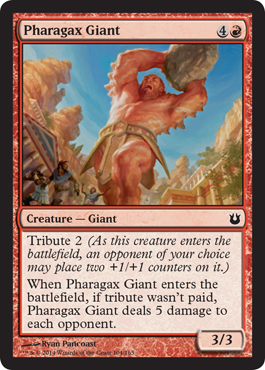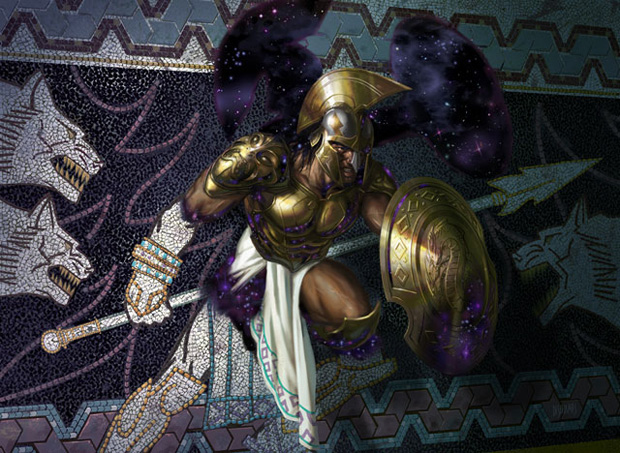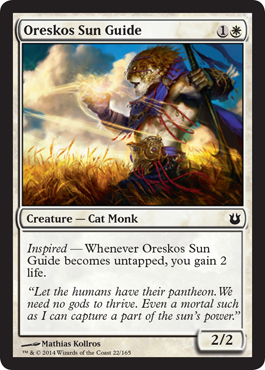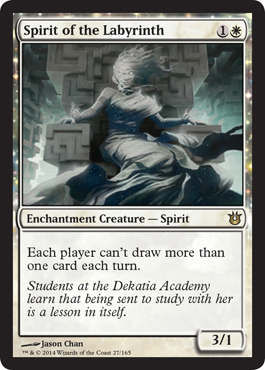Born Legacy
Welcome to the second week of Born of the Gods previews. Last week, I introduced the design team and the major mechanical components of the set. Today, I am going to be looking at the new things added and talk about why and how they got made. I also have another preview card for you before we're through. Sound good? Then let's get to it.
Tribute

Two weeks ago, I introduced you to a new phase of Magic design called advanced design. The idea of advanced design is that we start work on the design before the design team is assembled. Without the focus of a card file, the team has the freedom to prioritize the big picture and figure out what the whole block is up to.
The reason I bring up advanced design is because tribute was created by that team and not by the Born of the Gods design team. Let me walk you through how this happened. As I explained in my advanced design article, advanced design began as an experiment to test the holistic skill set of Ethan Fleischer and Shawn Main (the top two winners of the second Great Designer Search). To allow them the freedom to play in an area that wouldn't slow anyone down, I had them work on "Huey" block (that's the 2014 large October set).
Things were going so well that I decided to experiment a little more with the team. At the time, I was knee deep in Theros design and I realized that I was having the problem I always have—I was so busy trying to make the set come together that I wasn't having enough time to focus on the rest of the block. What if I took the team that was doing such great work on Huey block and focused it on Theros block design?
Ethan and Shawn had quickly figured out that they needed more design resources so they had tapped other designers (Ken Nagle and Dan Emmons) as well as a developer who was eager to do more design (Billy Moreno). I explained what Theros was doing and talked about where I saw the block going.
One topic was the enchantment creatures. The original plan was to introduce them as just the five Gods in Theros and then have them start turning up in greater and greater numbers as the block evolved. I asked the team to figure out where we could go with enchantment creatures, given my rule that they had to feel like both enchantments and creatures. This assignment led to the creation of the bestow mechanic.

Nyxborn Shieldmate | Art by Eric Deschamps
Billy Moreno had an idea for creatures that doubled as Auras and, with a little tweaking from the team, ended up with bestow (that version had the same cost to cast it either way; the idea that there was a separate cost to cast it as an Aura would happen in development). The plan was to use bestow as a new thing in Born of the Gods, but as I explained in my Theros preview article, Theros would later pull bestow back a set to solve a structural design problem.
With the success of bestow, I gave the team another assignment. I needed to solve a problem I refer to as mechanic drift. In a block, we start with a large set. Large sets, on average, have four or five mechanics. We then make a small set. A small set has at least one new mechanic but often will have two. Then, on blocks with a third small set (a third large set means we reboot the draft and players are playing exclusively with the third set), we have to make a least one more new mechanic and often two.
Mechanic drift is the problem that if you support all the mechanics throughout the block, the final set, which by definition is a small set with this problem, has as many as nine mechanics to support (Dragon's Maze was even worse than average, having ten mechanics to support). That's just a little bit too much, so we've been playing around with the idea that some mechanics advance—mostly the ones central to what the block is about and mechanically anchor the design—while some do not.
If I was going to discontinue one of the mechanics, which one should it be? Bestow is the glue that makes the math for the design work. It has to stay. Heroic was proving to be a major player in Limited and it had a lot of design space left. That meant our choices were down to devotion and monstrosity. Remember that scry wasn't added until development. Devotion was playing an important flavor role, plus we used it on the Gods and we were planning to make ten more Gods, so devotion had to stay. That left monstrosity.
Now, I liked monstrosity and I knew there was more design space left, but I also knew that a monster mechanic was a pretty meaty space to play in, so I made the call that Born of the Gods would change over its monster mechanic. The assignment to the team was to find a new one.
Here was what I asked for:
- It had to be a monster mechanic, meaning it had to be appropriate on cards that would be the size and shape of monsters and it had to be a creature mechanic.
- I wanted it to have a different feel from monstrosity. If we were going to change over the mechanic, I wanted it to feel different enough to be worthy of the change.
- I wanted it to make use of +1/+1 counters. This last one is hard to explain until we get to Journey into Nyx, but it had to do with an idea I had for the block plan. (That idea didn't actually come to fruition but I believed it would at the time. More on this story during Journey into Nyx preview weeks.)
With those parameters, I put the team to work. I believe Billy Moreno again came up with the basic concept of the new mechanic, this time one we called tribute (and yes, the name made it all the way through) and the advanced planning team iterated on it until it got very close to the version in Born of the Gods.
The team brought it to me during our weekly meeting. I liked it and tagged it for Born of the Gods. Now, the way this works is that when Born of the Gods started, I sat down with the lead designer, Ken Nagle, and walked through the work the advanced planning team had done. As Ken had been on the team for much of this work, this was a pretty simple meeting. I then explained to Ken that these were merely suggestions to help him with his design. He was free to use or not use any mechanics or cards made by the advanced planning team as he saw fit.
Ken liked tribute and put it in right away. The mechanic ended up requiring a deft hand in its creation (trying to capture both the right feel and fun game play is tricky) but the team quickly made tribute cards it liked and started playing them. While individual cards were changed, the mechanic itself had pretty smooth sailing all through design and development.
Inspired

One of the troubles design has is we're ahead of everyone else. When we start working on something it's before anyone has had much of a chance to even think about it. As such, we often have to make stuff up as filler until the proper team that is actually responsible gets to it. Now, I'm happy to say that we're starting to change how that process works. Advanced design has seeped into other parts of R&D and as a department we are, as a whole, thinking further and further ahead. That advancement, though, was not yet in place when Theros design started.
I had talks with Brady Dommermuth, the then-head of the creative team, about Theros. I had some cool ideas about why the enchantment creatures were intricately linked to the gods and Brady liked a lot of my ideas. They were swamped at the time and Brady said for me to just plow ahead with my own story framework and that the creative team would do its thing down the road when it got to it.
My original story had a dark version of Jace attacking the world with its own dreams. Because this idea of a dream state was important at the time, I made a mechanical choice of how to represent it. A creature in a tapped state was resting and thus could dream. We made numerous spells, for example, that were flavored as sleep spells, and what they did was tap and lock down a creature.
Now, in my original story, I needed a way for the denizens of the world to dream up creatures that would later attack them. Using my metaphor of tapping as sleep, I came up with the idea of activations that could only be used if the creature was tapped. The idea was that the controller of the creature had this challenge to get his or her creature to sleep and, if he or she could, the creature would then tap into the power of its dreams.
Remember that all of this was done knowing that the creative team would come in and fine-tune the story. I don't want to give anything away, so you'll have to trust me that everything ties together.
Now, when Ken started up Born of the Gods, I handed him the "dreaming" mechanic. The team then worked on it and made cards. The first thing we discovered was that having an ability without a tapping restriction meant that players would use the abilities multiple times. To try and stop this, we experimented with having the abilities untap the creatures as a rider.
This led us to discover that we had basically made abilities with an untap symbol while not using the untap symbol. For those unaware, the untap symbol was a mechanic used in the Shadowmoor block where a creature had to untap as a cost. While the ability seemed simple enough on the surface, we found that it actually proved hard for a lot of players to process.

In addition, untapping was often a positive side effect so, often, the abilities were used not for the ability but rather as a means to untap the creature. In addition, the tapping restriction meant that the abilities were most often used by attacking creatures. The intent wasn't that it was an attacking mechanic, so this was playing very differently from how we envisioned.
As a quick aside, sometimes mechanics doing something different is fine and it leads you to reinvent the mechanic. Sometimes, though, as with inspired, where you drift is not where you want the mechanic to be.
When we stopped to think about what we wanted, it was this: If you manage to get your creature tapped and survive the turn, at the start of your next turn, you get rewarded. That is when the team came up with the idea of having a trigger for the abilities, one that triggered when the creature untapped. It only took a few playtests to show that this version captured the feel we wanted.
Meanwhile, there was one other issue that I was trying to address. There was a lot of debate about what could count as an enchantment creature. I felt very strongly that I wanted the enchantment creatures to have elements of both enchantment and creature. Couldn't there be a way, though, to get a vanilla enchantment creature onto the battlefield? With some thought, I came up with a compromise, what if token creatures could be vanilla enchantment creatures?
We are always striving to keep our tokens as simple as we can. Being an enchantment would be enough of an extra thing, so I agreed to allow vanilla enchantment creature tokens to exist. Inspired seemed like a great place to use this ability. We liked it so much that we ended up making a whole cycle of creatures with inspire that make vanilla enchantment creature tokens.
Inspired is a good example of a mechanic that started from a very different place but ended up filling an important need in the design.
Global Enchantment Creatures
Remember this card from Future Sight?
This was my first attempt at an enchantment creature. The version I designed had a global enchantment effect but it was removed during development because the set was too complicated. While I agreed the set needed to lower its complication (and, by the way, it missed on this regard big time), I felt removing the global effect ruined Lucent Liminid. I obviously lost that fight, but I wanted to make sure that Theros block wasn't going to repeat the mistake.
What all this means is that the global enchantment creature was the one type of enchantment creature I knew I wanted to make when Theros design began. Interestingly, I made the call not to use it in Theros because I wanted to hold back on introducing the enchantment creatures. Yes, the Gods would be enchantment creatures, but people would just chalk that up to them being, well, weird Gods. The big original surprise of Born of the Gods was going to be the introduction of the rank-and-file enchantment creatures.
We would later pull bestow into Theros, which meant that the global enchantment creatures had to be held off for Born of the Gods. Development would later pull the few remaining global enchantments from Theros because it was clear we needed to preserve the design space for the global enchantment creatures.
Enough talk, let me show you an example of what we're doing. My preview card today is a global enchantment creature. Let me introduce you all to Spirit of the Labyrinth.

One of the big discussions we had about the global enchantment creatures was that normal creatures can basically have global enchantment effects. What makes these feel any different? My answer was that there will be ways to take advantage of their enchantment nature. Also, because the creature is vulnerable to both creature destruction and enchantment destruction, the development team felt able to push it a little.
You'll see, in Born of the Gods, that to try and make some of these creatures feel extra enchantment-y, some of them have not one, but two global effects—ones that have some thematic connection and/or synergy with one another.
Born Free
That's all the time I have for today. I'm very curious to hear all of your impressions of the new set. send any feedback about the set, positive or negative, to my email, post it in the thread to this column or let me hear it through any of my social media (Twitter, Tumblr, Google+).
Join me next week when I tell some card-by-card stories.
Until then, may your dreams bring you good things.

